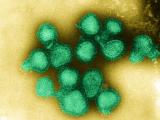Jun 2, 2011 (CIDRAP News) – A study from Australia suggests that a vaccine-induced surge of cytokines (pro-inflammatory chemical messengers) might have been a factor in the unusual rate of fever and seizures seen in Australian children who received the Fluvax seasonal flu vaccine last year.
The adverse events prompted suspension of use of the vaccine in children under age 5 in Australia in 2010, and the problem remains unexplained.
Writing in Vaccine, researchers in Perth, Australia, report that 190 children presented at a tertiary pediatric hospital for treatment of adverse events that occurred within 12 hours after vaccination with Fluvax or Fluvax Junior, made by CSL Ltd. Most of the children had a rapid onset of fever and vomiting, and 28 (14.7%) of them were hospitalized.
The researchers analyzed plasma samples available from six of the children and found that the levels of two fever-causing cytokines were significantly higher than normal, and the levels of several others were borderline high.
To test the hypothesis that the adverse events were related to high cytokine responses, the researchers then prepared cultures of peripheral blood mononuclear cells (PBMCs) collected from healthy children under age 3 and challenged them with Fluvax or one of two other flu vaccines, Influvac (made by Solvay) and Vaxigrip (Sanofi Pasteur).
Concentrations of six cytokines were found to be significantly higher in the Fluvax-challenged PBMC samples than in the others. However, the researchers also found that stimulation of samples with the 2009 version of Fluvax also led to higher cytokine levels, even though that older version of the vaccine had not been associated with increased adverse events.
"This might suggest that vaccine-induced pyrogenic cytokine responses alone are not sufficient to trigger severe adverse events like those seen in 2010," they write, adding that individual susceptibility to adverse events may vary.
Overall, the authors say their findings "suggest that the TIV [trivalent inactivated vaccine] component that led to the innate response relates to the methods of vaccine preparation and has been present in previous Fluvax preparations."
"Clear differences in cytokine production were observed when peripheral blood mononuclear cells were stimulated with Fluvax compared with alternate TIV preparations," the authors conclude. "Increased awareness of these potential adverse events is required to ensure earlier detection and prevention in the future."
Blyth CC, Currie AJ, Wiertsema SP, et al. Trivalent influenza vaccine and febrile adverse events in Australia, 2010: clinical features and potential mechanism. Vaccine 2011; early online publication Jun 1 [Abstract]
See also:
Jun 1, 2010, CIDRAP News story "Australian flu-vaccine probe confirms increased reactions in small children"




















